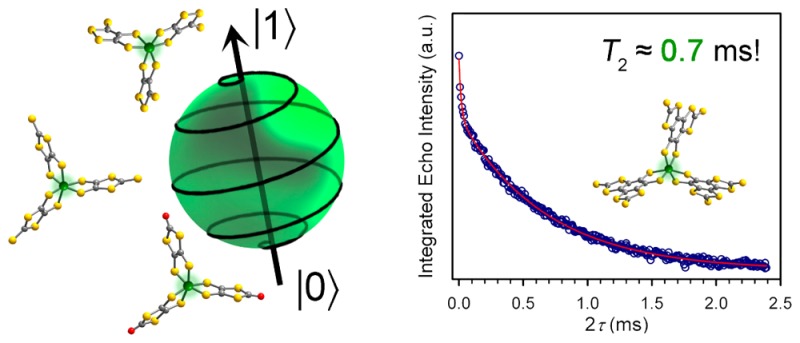- Record: found
- Abstract: found
- Article: not found
Millisecond Coherence Time in a Tunable Molecular Electronic Spin Qubit

Read this article at
Abstract

Quantum information processing (QIP) could revolutionize areas ranging from chemical modeling to cryptography. One key figure of merit for the smallest unit for QIP, the qubit, is the coherence time ( T 2), which establishes the lifetime for the qubit. Transition metal complexes offer tremendous potential as tunable qubits, yet their development is hampered by the absence of synthetic design principles to achieve a long T 2. We harnessed molecular design to create a series of qubits, (Ph 4P) 2[V(C 8S 8) 3] ( 1), (Ph 4P) 2[V(β-C 3S 5) 3] ( 2), (Ph 4P) 2[V(α-C 3S 5) 3] ( 3), and (Ph 4P) 2[V(C 3S 4O) 3] ( 4), with T 2s of 1–4 μs at 80 K in protiated and deuterated environments. Crucially, through chemical tuning of nuclear spin content in the vanadium(IV) environment we realized a T 2 of ∼1 ms for the species ( d 20-Ph 4P) 2[V(C 8S 8) 3] ( 1′) in CS 2, a value that surpasses the coordination complex record by an order of magnitude. This value even eclipses some prominent solid-state qubits. Electrochemical and continuous wave electron paramagnetic resonance (EPR) data reveal variation in the electronic influence of the ligands on the metal ion across 1– 4. However, pulsed measurements indicate that the most important influence on decoherence is nuclear spins in the protiated and deuterated solvents utilized herein. Our results illuminate a path forward in synthetic design principles, which should unite CS 2 solubility with nuclear spin free ligand fields to develop a new generation of molecular qubits.
Abstract
We observe a millisecond coherence time for a coordination complex qubit, surpassing the previous record for such a system by an order of magnitude.
Related collections
Most cited references30
- Record: found
- Abstract: found
- Article: found
